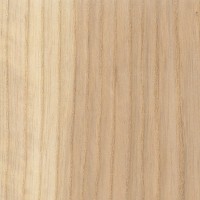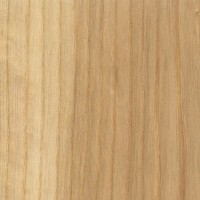 |
Common Name(s): Pumpkin Ash Scientific Name: Fraxinus profunda Distribution: Eastern North America Tree Size: 50-65 ft (15-20 m) tall, 2-3 ft (.6-1.0 m) trunk diameter Average Dried Weight: 36 lbs/ft3 (575 kg/m3) Specific Gravity (Basic, 12% MC): .48, .58 Janka Hardness: 990 lbf (4,400 N) Modulus of Rupture: 11,100 lbf/in2 (76.6 MPa) Elastic Modulus: 1,270,000 lbf/in2 (8.76 GPa) Crushing Strength: 5,690 lbf/in2 (39.2 MPa) Shrinkage: Radial: 3.7%, Tangential: 6.3%, Volumetric: 12.0%, T/R Ratio: 1.7 |
Color/Appearance:The heartwood is a light to medium brown color. Sapwood can be very wide, and tends to be a beige or light brown; not always clearly or sharply demarcated from heartwood. Pumpkin Ash tends to be a bit darker in color than the White Ash (Fraxinus americana) pictured above.
Grain/Texture: Has a medium to coarse texture similar to oak. The grain is almost always straight and regular, though sometimes curly or figured boards can be found.
Rot Resistance: Heartwood is rated as perishable, or only slightly durable in regard to decay. Ash is also not resistant to insect attack.
Workability: Produces good results with hand or machine tools. Responds well to steam bending. Glues, stains, and finishes well.
Odor: Gives off a distinct, moderately unpleasant smell when being worked.
Allergies/Toxicity: Ash in the Fraxinus genus has been reported to cause skin irritation, and a decrease in lung function. See the articles Wood Allergies and Toxicity and Wood Dust Safety for more information.
Pricing/Availability: Ash is among the least expensive utility hardwoods available domestically; it should compare similarly to oak in terms of price.
Sustainability: This wood species is not listed in the CITES Appendices, but is on the IUCN Red List. It is listed as critically endangered due to a projected population reduction of over 80% in the next three generations, caused by effects of introduced taxa. (See notes on the emerald ash borer in the comments section below.)
Common Uses: Flooring, millwork, boxes/crates, baseball bats, and other turned objects such as tool handles.
Comments: The emerald ash borer (Agrilus planipennis), believed to have been inadvertently introduced from Asia sometime in the 1990s, was first detected in Michigan in 2002. Lacking natural predators, uncontrolled populations of this invasive species spread very rapidly throughout North America, devastating local populations of ash trees. The beetles’ larvae bore into a tree and feed on the inner bark, eventually killing the entire tree. The insects are responsible for the deaths of hundreds of millions of ash trees across the United States and Canada. Green Ash and Black Ash trees are preferentially attacked by the insects, followed by White Ash and Blue Ash.
Pumpkin Ash is one of a handful of species in the Fraxinus genus that are used as commercial lumber. It’s not quite as strong or dense as the related White Ash (Fraxinus americana).
When stained, ash can look very similar to oak (Quercus spp.), although oaks have much wider rays, which are visible on all wood surfaces—even on flatsawn surfaces, where they appear as short, thin brown lines between the growth rings. Ashes lack these conspicuous rays.
Scans/Pictures: There are currently no pictures of this exact wood species, but a similar species within the Fraxinus genus is being substituted (F. americana). If you’d like to contribute a wood sample of this specific species to be scanned, (even small pieces of veneer can be sent), please use the contact form.






this wood is amazing, my bass guitar is made from this, apparently this wood is known as swamp ash, also known as red ash, that’s what I read from an instrument maker ash related article “”red ash” also known as “pumpkin ash” (fraxinux prufunda) which is what we guitar makers call “swamp ash”, a tree growing in the swamp areas of Mississippi and Alabama”
https://www.frudua.com/guitar_woods_ash.htm